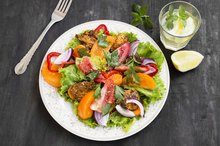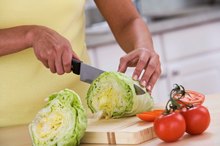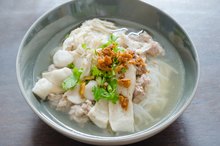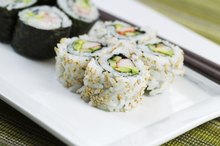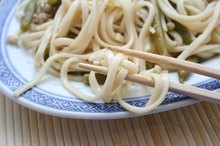What does fact checked mean?
At Healthfully, we strive to deliver objective content that is accurate and up-to-date. Our team periodically reviews articles in order to ensure content quality. The sources cited below consist of evidence from peer-reviewed journals, prominent medical organizations, academic associations, and government data.
The information contained on this site is for informational purposes only, and should not be used as a substitute for the advice of a professional health care provider. Please check with the appropriate physician regarding health questions and concerns. Although we strive to deliver accurate and up-to-date information, no guarantee to that effect is made.
Nutritional Information of Fried Crispy Chow Mein Noodles
When it comes to ethnic fast food, Chinese makes a fairly healthy choice because of its emphasis on vegetables, lean proteins and vegetable oils. But not all Chinese food and products are healthy. Fried chow mein noodles are crispy noodles added to Chinese salads for nuttiness and crunch. But these noodles also add calories, fat and sodium and little nutritional value to a healthy salad.
Calories
A 1/2-cup serving of fried crispy chow mein noodles contains on average 131 calories. Fried crispy chow mein noodles are a calorie-dense food, meaning they have a high calorie count compared to their serving size. By comparison, 2 cups of mixed greens contains 50 calories. Adding even a 1/4-cup serving of the noodles to your salad increases its calorie content by 65 calories. Eating too many calorie-dense foods can cause you to consume too many calories and lead to weight gain 3.
- A 1/2-cup serving of fried crispy chow mein noodles contains on average 131 calories.
- Adding even a 1/4-cup serving of the noodles to your salad increases its calorie content by 65 calories.
Fat
Nutrition in Applebee's Oriental Grilled Chicken Salad
Learn More
Some of the calories in the fried crispy chow mein noodle come from its fat content. A 1/2-cup serving contains 5 g of total fat and 1.3 g of saturated fat. While fat is an essential nutrient, providing energy and helping you absorb essential vitamins, consuming too much fat can increase your risk of obesity and heart disease. You should limit your intake to less than 30 percent of your daily calorie needs. On a 2,000-calorie diet, that means limiting your daily fat to less than 66 g a day.
- Some of the calories in the fried crispy chow mein noodle come from its fat content.
- You should limit your intake to less than 30 percent of your daily calorie needs.
Carbohydrates
As a flour-based product, most of the calories in fried crispy chow mein noodles come from their carbohydrate content. A 1/2-cup serving contains 19 g of carbohydrates. Carbohydrates are also an essential nutrient, providing your body with energy. In fact, most of your daily calorie intake should come from carbohydrates. A healthy diet should get 45 to 65 percent of its calories from carbs.
- As a flour-based product, most of the calories in fried crispy chow mein noodles come from their carbohydrate content.
- In fact, most of your daily calorie intake should come from carbohydrates.
Protein
Nutritional Facts for Oatcakes
Learn More
Although not significantly high in protein, a 1/2-cup serving of chow mein noodles provides 3 g of protein, meeting 6 percent of your daily value. The percent daily value is based on a healthy diet for adults containing 2,000-calories. Because the noodle is a plant-based food, it does not provide all of the essential amino acids your body needs to function properly.
Sodium
The sodium content of fried crispy chow mein noodles can vary depending on the source of the noodle. On average, a 1/-2-cup serving contains close to 200 mg of sodium, meeting 8 percent of your daily value. Sodium intake needs to be limited to reduce your risk of developing high blood pressure. You daily intake should be less than 2,300 mg a day.
- The sodium content of fried crispy chow mein noodles can vary depending on the source of the noodle.
- You daily intake should be less than 2,300 mg a day.
Related Articles
References
- Center for Science in the Public Interest; Wok Carefully: CSPI Takes a (Second) Look at Chinese Restaurant Food; March 2007
- Cook's Thesaurus; Asian Wheat Noodles; Lori Alden; 2005
- Mayo Clinic; Energy Density and Weight Loss: Feel Full on Fewer Calories; January 2011
- Felix A, Tuano APP, Mallillin A, Trinidad T, Juliano BO. Short-term satiety of brown rice and milled rice. Phillipine J Crop Sci. 2016;41(1):52-59.
- Restaurant, Chinese, chicken chow mein. FoodData Central. U.S. Department of Agriculture. Published April 1, 2019.
- Chicken chow mein. FoodData Central. U.S. Department of Agriculture. Published April 1, 2019.
- Egg roll, with shrimp. FoodData Central. U.S. Department of Agriculture. Published April 1, 2019.
- Roll with meat and/or shrimp, vegetables and rice paper (not fried). FoodData Central. U.S. Department of Agriculture. Published April 1, 2019.
Resources
Writer Bio
Jill Corleone is a registered dietitian and health coach who has been writing and lecturing on diet and health for more than 15 years. Her work has been featured on the Huffington Post, Diabetes Self-Management and in the book "Noninvasive Mechanical Ventilation," edited by John R. Bach, M.D. Corleone holds a Bachelor of Science in nutrition.
